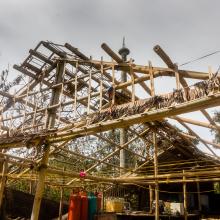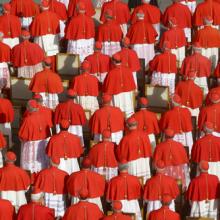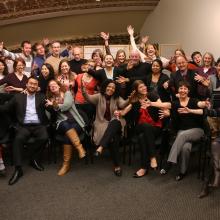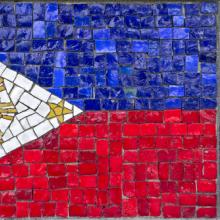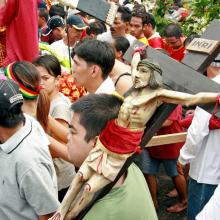Philippines
IN THE EARLY evening of Nov. 8, 2013, Arnel Montero convinced his mother, wife, and three children to evacuate to a two-story concrete house above the coastal area of Barangay 70, a fishing village in Tacloban City, on the island of Leyte in Central Philippines. He expected the worst, with the news reporting the arrival of super-typhoon Haiyan the following morning, and thought the house would be a safe place where his family could take shelter while he remained in their shanty by the coast.
Even though Haiyan’s fury hit the islands at speeds surpassing 200 miles per hour, the strong winds alone would not have created such a major tragedy. But Haiyan precipitated a storm surge that led to grave loss of life and massive devastation. Barangay 70 is located near the city’s main pier, and the tidal waters pushed cargo boats toward the coast, smashing shanties and buildings, including the concrete house where Arnel’s family sought shelter. Arnel managed to save himself, but the rest of his family perished.
The National Disaster Risk Reduction and Management Council, as of mid-March 2014, reported 6,268 deaths, although the actual number could be double that. In Barangay 70 alone, there were close to 300 people who died. An estimated 12.2 million Filipinos were affected by the disaster that hit eight provinces in the Visayas islands region; close to 2 million houses were either washed out or partially destroyed.
The national and local government’s response to the massive need for relief operations was slow. Political bickering, incompetent local governments, and the sheer inefficiency of the administration of President Benigno Aquino all contributed to major delays in bringing food, potable water, clothing, medicine, and temporary shelter to the survivors. Weeks after Haiyan struck, interior villages still had not received aid. It was not until early January 2014 that government relief agencies managed to set up the systematic distribution of relief goods.
IN MINDANAO, Philippines, a cheer went up: Mayron tayong cardinal! (“We have a cardinal!”) In January, Orlando B. Quevedo, archbishop of Cotabato, was one of 19 new cardinals named by Pope Francis.
Cardinal Quevedo rose from newsboy to archbishop. He’s renowned for his interreligious work and cofounding a Catholic-Muslim peace community in the southern Philippines where there is violent ethnic conflict. Quevedo is a leader in the Federation of Asian Bishops’ Conferences, a body representing more than 100 million Catholics that has courageously pushed forward the values of Vatican II amid traditionalist backlash.
During a papal conclave, when a new pope is chosen, much of the world, Catholic and otherwise, pays close attention to the news ticker from the Vatican. For the selection of new cardinals, not so much. But with Francis, everything bears watching.
Historically, cardinals were called “the princes of the church” because of the power they wielded. Functionally, they serve in the College of Cardinals, which meets with the pope to deal with questions of major importance and elects new popes. Sadly, scoring a red hat has been for some the acme of clerical ambition. The season of cardinal picking can devolve into extravagant indulgence.
But, there’s a new sheriff in town: Pope Francis wants deputies, not darlings.
Overheard on a Facebook conversation last week: “There is really not much difference between compassion and pity when it comes to being on the receiving end of it.” This thought gave me pause as I consider compassion to be a central tenet of biblical justice, and yet, I experience this to be true. We use the fancy spiritual term of “compassion” when the gist of the sentiment is, indeed, pity.
The above conversation rose out of a discussion on the viral story of Pope Francis kissing the disfigured man. The media reporting the story highlights the compassion of the Pope, how his actions are pushing outside the box of the papacy, and how revolutionary his love was. Other than a brief medical description of the disfigured man’s disease, there is no additional information on who he is, where he lives, or whether he has a family. We are not even given his name. The buzz generated by this story arises out of an awed respect for someone who could even consider touching such a pitiful, nameless person. I can’t help but wonder how this man feels to have the world captivated by somebody showing love to himself. It seems to me his deformity has been made into a public spectacle.
Time became suspended for my family and me when Typhoon Haiyan struck the Philippines nearly a month ago.
Days blurred into one another as my mom attempted to contact her family in Leyte, one of the Philippine islands directly hit by Haiyan. With her mother, siblings and family members still living in the Philippines, my mom feared the worst as she helplessly watched news reports of the typhoon’s devastation and destruction.
Together, as a family, we waited in agony for answers. Would my grandma and relatives survive? If so, when and how would they contact us without power or phone lines? Would this storm wipe out every connection we have to my mother’s homeland?
Two weeks after Haiyan upended our lives, grief gave way to joy as we received word of my family’s safety. My nanay (grandma) and several of my titas (aunts) and titos (uncles) lost their homes, but they managed to survive one of the most powerful storms recorded in modern history.
As you can imagine, there was much to be grateful for when I gathered with my family for Thanksgiving. At our table, we gave thanks to God for this miracle, knowing all too well that many Filipino families were not as fortunate or still waiting for news about their loved ones. We also remembered those who helped us during this time of uncertainty, especially the Sojourners community.
The latest United Nations climate summit got off to an unusually emotional start when Yeb Sano, the head delegate from the Philippines, issued a tearful plea at the opening plenary.
With his country ravaged by Typhoon Haiyan — the kind of extreme weather that experts say is becoming more common due to climate change — Sano choked back tears as he announced he would fast in solidarity for his countrymen left without food.
Sano said on Nov. 11 he would refrain from eating during the conference unless important progress was made. Sano’s gesture has so far failed to trigger much of a change in the entrenched negotiations, and with talks expected to stretch into the weekend, he is still on his hunger strike.
LAST OCTOBER, A historic breakthrough for peace took place in Mindanao. In this region in the southern Philippines, an armed conflict has persisted for more than four decades, killing 120,000 people and displacing millions. Now, after 15 years of peace negotiations between the government of the Philippines and the Moro Islamic Liberation Front, both sides have signed a framework peace agreement.
For generations, Moro (as traditionally Islamic ethnic groups are called here) and indigenous peoples in Mindanao have been politically, economically, and socially left out and marginalized in the Philippines. It is in this context—and the collective desire of the Moro people in Mindanao for self-governance—that both the armed conflict and the peace negotiations took place. The agreement signed in October outlines a pathway toward the establishment of a political entity, Bangsamoro, that will be autonomous, although not fully independent of the Philippines.
The framework agreement is a welcome consolidation of a long-term peace process that has encountered significant challenges, including periods of lackluster support from the international community and a less-than-successful 1996 peace agreement with the Moro National Liberation Front (from which the Moro Islamic Liberation Front is a breakaway group).
Since the ban on international trade of ivory in 1989, the ivory black market has been on the rise, and a National Geographic investigation found that demand for religious art pieces carved out of the precious material has played a considerable role.
“No matter where I find ivory, religion is close at hand,” said investigative reporter Bryan Christy, whose article, “Ivory Worship,” is included in the new edition of National Geographic magazine, released Sept. 14.
“Elephant poaching levels are currently at their worst in a decade,” Christy wrote. The Convention on International Trade in Endangered Species of Wild Fauna and Flora (CITES) estimates that at least 25,000 elephants were poached in 2011, mostly for their ivory tusks.
Philippine Catholics use ivory to construct crucifixes, figures of the Virgin Mary and other icons. The province of Cebu is particularly known for its ivory renditions of the Santo Nino de Cebu (Holy Child of Cebu), used in worship and celebration.
According to Reuters (via Chicago Tribune):
An earthquake of 7.9 magnitude struck off the Philippines on Friday and a tsunami warning has been issued for the region, the U.S. Geological Survey and the Pacific Tsunami Warning Center said.
The quake was centered off the east coast, 91 miles off the town of Guiuan in Samar province at a depth of about 20 miles, USGS said.
The tsunami warning was issued for the Philippines, Japan, Indonesia, Taiwan, Papua New Guinea and other islands in the Pacific including the U.S. state of Hawaii.
"An earthquake of this size has the potential to generate a destructive tsunami that can strike coastlines near the epicenter within minutes and more distant coastlines within hours," the Pacific Tsunami Warning Center said.
The quake struck just before 8:50 p.m. local time, the agency said.
There were no immediate reports of damage or injuries.
Belief in God is slowly declining in most countries around the world, according to a new poll, but the truest of the true believers can still be found in developing countries and Catholic societies.
The “Beliefs about God Across Time and Countries” report, released Wednesday (April 18) by researchers at the University of Chicago, found the Philippines to be the country with the highest belief, where 94 percent of Filipinos said they were strong believers who had always believed.
At the opposite end, at just 13 percent, was the former East Germany.
Melissa Roxas is someone I am proud to call a friend. When I met her three years ago, I was struck by her deep desire to return to the Philippines to provide volunteer services to impoverished communities.
